In and Out of Africa
In the Desert Again
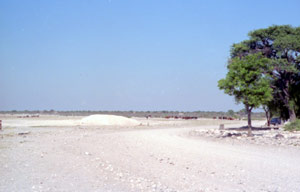 |
| Desert Road |
|---|
As we entered Namibia I was struck with a feeling that this was a special place, as if a great burden had been lifted from my shoulders. Maybe it was the feeling of welcome from the friendly smiling customs officials, perhaps it was the policeman in the first town who, seeing us stopped on the roadside looking puzzled asked if we needed any help. "We're looking for the road to Windhoek". "Follow me", he replied taking us to the right road and waving cheerfully as he drove away. People seemed happier here, less affected by the troubles of the rest of Africa.
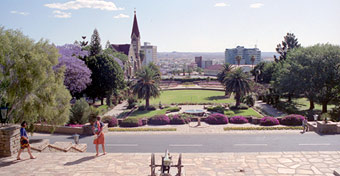 |
| Windhoek |
|---|
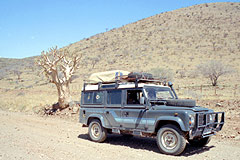 |
| The truck and a baobab tree |
|---|
From the highest point you could see the mountains give way to the flat plains of the Namib Desert beyond, stretching into the haze on the horizon. The Namib is a narrow stretch of desert trapped between the mountains and the sea. Here, at about its widest point, it is only about 180 km wide. In this short distance we passed from the semi-arid scrub land of the desert fringe through progressively drier countryside to the parched desert plain. It had taken three or four days to go through the transition from mountains to desert driving south into the Sahara. Compressed into a few hours the scene changes were startlingly obvious as trees and bushes gave way to grass and small scrubby bushes and then to sparse dry grass followed by dry stony desert. The Namib is however far from dead and quite unexpectedly we came across on of the most elegant animals in the world. There, standing aloof in the distance, standing sideways, its head characteristically facing towards us and long slightly curved horns held high, was a solitary oryx. Now all but extinct in the North African and Arabian deserts this is one of the few places where they are still thriving.
Although Namibia has finally been granted independence from South Africa, the Pretoria regime has retained control of a little enclave next to Swakopmund called Walvis Bay. They claim the right to this land because it was originally annexed by the British colony at Cape Town. The reason they retained this piece of land is because it is the only deep water port in Namibia. Resentful that international and internal pressure forced them to give up control of Namibia they retained Walvis Bay to allow them an economic stranglehold on the country. This also brings about a situation where two of the four roads which enter Swakopmund pass briefly through South African territory. As we neared this border we realised that Fiona only had a single entry Namibian visa. If they stamped her passport when we crossed the border we would be in a situation where, having entered a 5 kilometre stretch of South African territory we couldn't then return to Namibia. There would not, of course, be a Namibian embassy in the middle of the desert and probably wasn't one in Walvis Bay either. Even if there was the only way to Walvis Bay would be to drive straight across the desert which is both dangerous and prohibited. Hopefully the South Africans wouldn't be so pedantic as to place a border post here in the middle of the desert.
There, in the middle of the desert, was a fence and a caravan. There was nothing to say that this was the border or that we should stop. For a moment I entertained the idea of driving through. Something told me that this would not be the best plan and we stopped. After no one appeared for about three minutes I began to reassess the situation and started the engine again. A lone African soldier, who was either asleep or in the toilet, appeared from inside the caravan. He came over, checked our documents, wrote down the vehicle registration number and let us continue. Five kilometres later we arrived at the next border post, a tent next to the road, again with no indication that we should stop. This time the African soldier was waiting for us, perhaps warned by radio of our imminent arrival. We handed over the passports. He looked at them for a moment and said. "Ah, New Zealand, you have these - bloop bloop", while doing the international sign language for boiling mud pools. Considering most people think, like Mark Twain, that New Zealand is near Australia or Asia or somewhere and you travel to it over a bridge, to meet an African who knows about the boiling mud pools is remarkable indeed.
The river Swakop passed under the road during this brief excursion into South Africa. It was dark and muddy, more of a marsh than a river. During the rare rains in this, one of the most arid desert regions in the world, the river is packed full of dark brown detritus from the mountains and desert. The effect is apparently rather reminiscent of a loose evacuation of the bowels. Perhaps not surprisingly, Swakop, in the local dialect, means exactly that. We were a little uncertain as to what to expect from a town whose name is roughly translated as 'mouth of shit river'.
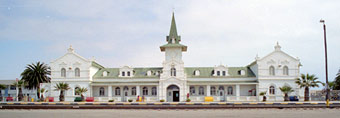 |
| Swakopmund Station |
|---|
In contrast to its name it is a smart little town with many incongruous German colonial style buildings. The railway station for example, with its arched windows and small spire, would have looked quite at home near the banks of the Rhine covered in snow. Here only the palm trees remind you that you are really in Africa.
Swakopmund is a seaside town and in colonial times was the German colony's only seaport, Walvis Bay then being under British control. Now it is mainly a resort town where people come to escape the searing summer heat. Fiona and I hadn't seen the sea for nearly eight months and the sight of the breakers coming into shore was a welcome change from jungles and deserts. The sight of the sea had a strange effect on Fiona and June. Being New Zealanders they are used to the warmth of the Pacific Ocean and tend to rush straight into the sea whenever possible. I was brought up surrounded by the cold Atlantic and therefore tend to be much more sceptical about rushing into headlong into the breakers. This was the Atlantic, more than that this was an Atlantic current which came straight up the coast from the Antarctic without heating up appreciably on the way. I tried to explain that, even though the outside temperatures were in the 30°deg;s, the water would be close to freezing. I also tried to explain that the reason the Namib was so dry is due to the extremely cold current resisting evaporation and capturing any moisture blown landward and effectively blocking cloud formation. They didn't believe me. As they kicked off their shoes, lifted their skirts and rushed into the surf their shrieks soon proved that I was right. They did continue paddling for two or three minutes before admitting defeat and coming back to the Landrover to warm up.
A Namibian couple were watching this strange behaviour and assumed that we were foreigners. When they saw the Landrover with British number plates and NZ stickers on the side they realised where these foreigners had come from. They stopped and talked to us for awhile. They had lived all their lives in Namibia yet they spoke with strong German accents, another legacy of the German influence. When they found out we were planning to stay at they campsite in town they said, "You don't want to stay there, it's dirty and expensive, come and stay with us. we have a spare room". The Poller's house was near the centre of town, it had a small courtyard with a gate. We decided that it would be safer if we managed to get the truck inside. The gateway had a crosspiece which we could easily get under. Beyond that were a series of low poles for creeping plants to grow along. I slowly drove the truck under the arch. We started out with plenty of room to spare. We got under the arch but as the truck got further into the courtyard the head room diminished. "Stop", Fiona shouted. I gently got out of the truck. We had less than a metre left to go. The truck was at a slight angle and there was plenty of headroom on the drivers side but the passenger side was almost touching the archway. "Perhaps we could let the tyres down?", I suggested. Mr Poller said, "If we all hang onto this side you might get through". "Yes", I said, "That should work". I started forward again, this time with three people hanging off the side of the truck. With very little room to spare we cleared the last of the trellis poles and were inside.
The guest room was comfortable enough and had enough beds for all three of us. Unfortunately the house was opposite 'Garfield's Pub' (as in the stupid fat cartoon cat) and they had chosen this night to have a major all night party.
In the morning the town was covered in a thick cold salty mist. Almost every night throughout the year, as the hot desert cools down the mist forms from the cold ocean and rolls inland up to 50 km. It is this mist which sustains the rich ecosystem of the Namib Desert. As well as being one of the driest deserts in the world it is also one of the oldest and a large variety of unique animals and plants have evolved to take advantage of the daily influx of moisture. The roads in the town are also uniquely dependant on the daily mist. The roads appear to be have some kind of hard concrete surface. In fact they are sharp grained desert sand cemented together with a mixture of salt and gypsum, a common mineral in deserts. This combines to form a cheap material which is easy to maintain and almost as good as a tar sealed or concrete road. Without the daily mists the gypsum and salt would form fine dry crystals and this wonder material would simply blow away.
We spent most of the day exploring this rather quaint little town, visiting the tourist information centre, the railway station, the curio shops and a cafe selling German style coffee and cakes. In the afternoon we went to visit the Poller's son Helmut. He had recently been made redundant and had received a reasonable amount of money in settlement. He was going to use this to finance an overland trip through Africa and naturally was very interested in our experiences.
Afterwards we all went for a walk down to the beach. Helmut carried on along the beach to Walvis bay. His Father had found himself in Walvis Bay without the proper I.D. Because Walvis Bay is South African territory there is effectively a border between the two countries. Rather than stamp peoples passports they simply check that each person has the relevant identity documents, or rather, sometimes they check and sometimes they don't. This time he had got into Walvis Bay without being checked. Unfortunately the Namibian officials were checking I.D. on the way back and wouldn't let him return home without any. Instead he had abandoned his car and walked home along the beach. Helmut was now walking back along the beach and would return across the bridge in the car. While we were walking several people in four wheel drive vehicles and pickup trucks drove along the beach into Walvis Bay and back, avoiding the border posts completely and making the situation quite ridiculous. Driving along the beach was one way around the problem of Fiona's single entry visa and would allow us to go and see the flamingoes. In the end we decided this was far too much of a risk for some birds and June could survive visiting Africa without seeing flamingoes as she'd been so lucky with other animals anyway.
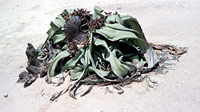 |
| Welwechia miribalis |
|---|
 |
| The magnificent oryx |
|---|
Sessriem campsite is on the edge of a vast dune field and is the nearest campsite to Sossus Vlei. The dunes here are reputed to be the highest in the world, the highest being at the vlei itself. Popular wisdom is that sand dunes are best photographed just after dawn when they glow red with the morning sun and the shadows give a sense of depth to the scene. This seemed to make a lot of sense, also the temperatures rise sharply and the early morning would be much more pleasant for walking around soft sand dunes. So we hoped for a good night's sleep before heading into the park at dawn, when the gates opened.
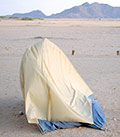 |
| June's tent |
|---|
Dawn broke and the wind seemed to calm down, as though surprised by the new day and unsure what to do next. None of us felt like driving to the dunes, only determination, and being too tired to make a new decision, drove us onward. The dunes were further away than I imagined and the road was badly corrugated. We stopped occasionally to photograph the dunes on either side, glowing red and with harsh edges of early morning shadow. At the vlei we drove the 4 km of the 4X4 track, through some soft sand, to the highest dune. It really is rather large, apparently 300 metres high but, to be quite honest, we were too tired to really care. We took a few photos and walked towards the dune, which was hard work in the shifting sand. I started climbing it, foolishly moving up the softer slope so my footprints wouldn't ruin the view for anyone who came later in the day. I needn't have bothered because as we were leaving a party of tourists started walking straight up the main face. By the time I got half way up it was starting to get hot, I was tired and developing a headache. I decided that the view from where I was more than adequate, took an all round panoramic photograph and headed back down.
 |
| The world's largest sand dune |
|---|
As we headed back the vlei was beginning to get crowded. One couple had walked from the 2 wheel drive car park along the 4 km track. It was quite hot by now and they looked very uncomfortable. We arrived back at the campsite after what should have been a wonderful experience, exhausted and irritable. As we opened the tent and went back to bed the wind began to blow once more.
Should we have waited and gone later in the day? Perhaps not. We spoke to another couple who had arrived not long after we had left who said it was hot and the wind was blowing a lot of sand around. It was even more windy the next night and much windier in the morning making taking the tents down a major undertaking. So we probably did the right thing. The photographs look good too.
The road continued through the desert with the dune field to our right. The scrubby wind torn plain punctuated by the lush green oases of irrigated homesteads. There were no crops and very few animals so it was hard to see why the homesteads had been built, although several were now occupied by the park staff.
We were now headed for Luderitz. Several people had told us we 'just have' to go to Luderitz. It sounded like a perfect German colonial town with all manner of endearing qualities about it. The Namibian publicity department described as a 'mosaic of its former self', whatever that means, Shoestring described it as an almost surreal living colonial relic. In fact it is best described as a dump which everybody, including the inhabitants have given up on. If it is a mosaic, the mosaic is run down and in desperate need of renovation, if any more tiles are lost the picture itself will disappear. Surreal perhaps, yet who would like to live in a Dali painting?
Luderitz is noted for its rock lobsters, which are exported the world over. Much to the Fiona's and June's disappointment there wasn't a fresh rock lobster to be found in the entire town, or even, to my own dismay, a decent German colonial style drinking establishment. The only redeeming feature was the campsite set on a rocky promontory extending into the bay. The view was worthwhile and we managed to face completely away from Luderitz itself, which was a bonus. The rocks themselves were twisted and moulded in a very Daliesque fashion and had obviously undergone great turmoil in the past, or maybe this is simply the effect Luderitz has on things which can't run away.
Just outside Luderitz is its main tourist attraction, the diamond mining ghost town of Kolmanskop, where the old mining town is being slowly engulfed by the encroaching sand dunes. We didn't stop, after all we'd already only just left a ghost town - called Luderitz!
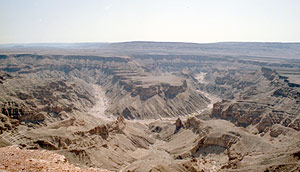 |
| Fish river canyon |
|---|
Looking down into the canyon the river is a long way down as it meanders gently within the wide curves of the canyon itself. We drove round from the main viewpoint, with a sheltered rest area, to the trail head. At the trailhead was a Volkswagen kombi van with two ladies on their own next to it. I walked a few hundred metres back along the track to try and photograph the truck with the canyon in the background. That was more than enough exercise in this kind of heat! I could see why entering the canyon, where it would be much hotter, was not recommended. As I returned to the trail head I was surprised to see two figures emerge from the steps next to the sign saying no entry September to February. They were two German tourists, a man in his forties and his father, and were with the ladies in the Kombi. Ignoring the notices (which they had seen) they decided to walk down the steep path to the canyon floor in sandals and with nothing to drink. Not surprisingly they were exhausted and dehydrated. They sat down in two deckchairs and drank all the cola they could find. I could now understand why the park has to be closed to protect people from their own stupidity. If this was the height of summer they would still have climbed down. The difference being they would probably not have returned.
On the road back to the campsite two secretary birds walked across the road in front of us. The secretary bird is a rather incongruous looking bird of prey, tall and visible with brightly coloured 'quills' on the top of its head. It is these feathers which give the bird its name, they are supposed to look like the quill pens used by scholars in the days before ballpoint pens had reached these shores. As usual the camera was packed away. The birds stopped in the bush, obscured by the tall grass and began looking for snakes and small reptiles to eat. In another attempt to emulate David Attenborough I sat on the spare tyre on the bonnet of the truck and Fiona slowly drove across country towards the birds. Whenever I was just about ready for that award winning photograph they would fly just a little further away. Eventually they decided to fly off completely and we returned to the road, once again without award winning photographs.
The campsite at Hobas was quiet and restful with plenty of trees and shade. We were just settling down to a quiet evening when a Rotel arrived. This was the first time we had seen one arrive and set up. As soon as the coach had come to a stop a couple of the passengers came around to the trailer, pulled out a couple of stabilisers and opened the back out. They then pulled out a canvas awning which hides the stairways and the entrances to the little tiny 'rooms'. Within ten minutes the trailer was ready for the evening and the once quiet campsite was now full of German tourists.
We had seen Rotels before but had never this close. The rumours from talking to other travellers, especially those on tour trucks, were that the passengers are generally noisy, unfriendly and, even though there is one whole luggage compartment converted to a beer fridge, they will never offer you any beer. Considering the travellers on tour trucks are generally noisy and never offer you any beer we were preparing for the worst while the toilet block filled up with noisy Germans going their washing.
The driver came over to us. "Would you like a beer?", he said. We spent the rest of the evening talking to all the friendly, talkative, but not really noisy, Germans. In fact they were probably more friendly than a most of the people on tour trucks. Rotel apparently travel all around the world only missing out a few of the more difficult areas, they don't cross the Sahara (although they drive as far as Tamanghasset) and they don't drive through Zaire. Which is hardly surprising. The only stipulation is that the passengers speak German, as the guides cannot be guaranteed to speak English. In fact the driver/guide on this particular truck spoke very good English and was curious about our adventures. He was based in South Africa and had spent the last three or four years driving around Southern Africa. The evening turned out to be much more pleasant than we had expected and, even though we went to bed earlier than the others they didn't make too much noise.
Throughout the whole trip I had been trying to make sure Fiona wore her boots, rather than wearing Jandals or even going barefoot. One traveller we met described having chiggers, which are hideous little tick like insects, removed from between his toes. Even after this it was only a few days before she began walking around the campsites barefoot again. In the whole of the trip she had never stepped on anything sharp, been bitten by anything, or had any nasty parasites crawl between her toes. In the middle of the night I felt the need to go to the toilet. For the first time in the whole trip I couldn't be bothered to put my boots on and slipped Fiona's jandals on. Almost as soon as I was out of the tent I tripped on a low wall and sliced my foot open. Which goes to show that I was right! I shouldn't walk around barefoot in Africa and I no longer attempted to advise Fiona on her foot wear.
After leaving Hobas we drove to Ai-Ais, which had chalets and hot pools. We were hoping to stay and relax here for a few days. Unfortunately the campsite was completely open with no shade whatsoever. The hot pools looked extremely tempting and the chalets opened out onto the pools. Unfortunately it was a little to expensive for us and we continued towards the South African border. The border crossing was quiet and easy. As we started on the long drive to Springbok the feeling of freedom and elation I had felt entering Namibia was replaced by a feeling of gloom and despondency.



